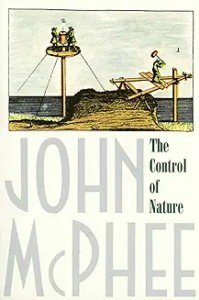The Control of Nature by John McPhee 1989
In this his 26th book, McPhee takes on a topic that is even more relevant and important today— how humans and nature should live together.
This fascinating and readable volume presages Elizabeth Kolbert’s “Under the White Sky” in which she explores several instances where man’s intervention to control or manage nature has resulted in a bad outcome. Interestingly, both McPhee and Kolbert focus on the diversion of the Mississippi River and the disastrous results for Louisiana and New Orleans.
In addition to the first chapter on the Army Corps of Engineers’ attempt to manage flooding, silt, and land use in the Mississippi/Atchafalaya River deltas, McPhee extensively reviews the 1973 attempts to divert lava from the town and the harbor in Heimaey, Iceland and the battle in Los Angeles to manage the debris coming off the San Gabriel Mountains.
In each of these three chapters, McPhee gives us his classic style—choose a fascinating and somewhat esoteric topic; find a fascinating and often quirky person engaged in dealing with that topic and describe them in wonderful detail (e.g. Miner Harkness , “a small compact man with alert blue eyes and dark brows, an intelligent and kindly face. His hair generally thinning, was gone in the back, his beard Vandykish and in two shades of gray.”; provide mountains of data and information in a form which is readily digestible( e.g. “In a productive season, the debris basins will catch more than a millioin cubic yards…The overall cleanout costs can excedd $60 million in a single year”. ; find the odd incident/event/person involved in this topic; write crystalline prose, often with tongue in cheek (“Part of my house was destroyed in 1969, but I am confident it won’t happen again. Fay is a professor of History at Caltech.”), and provide a brilliant take home message.
In this book, he explores how man has made things much worse by deciding to fight nature (war and battle are the metaphors consistenly used by the perpetrators of these disasters). The first chapter describes how the levees, dams, and control gates and locks the Army Corps of Engineers has built over the last 150 years have created the disaster of New Orleans’ flooding and loss of Louisiana’s land. The second chapter describes how pouring sea water on a lava flow from an active volcano may have saved a small town and harbor on an island off Iceland but would be futile when faced with Mauna Loa’s half million tons of molten material pouring forth every hour. Finally, he tells the story of how Los Angeles is engaged in a continuous struggle with the San Gabriel Mountains which annually drop millions of tons of debris rolling down the hills into people’s homes and swimming pools and sweeping away their cars, homes, and the land itself.
It’s an interesting and thought-provoking book with his usual wonderful cast of experts and regular people. Never disappointing, I’m already looking forward to reading the next book in McPhee’s ouevre.



